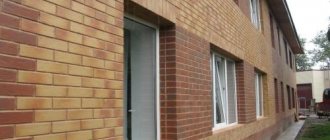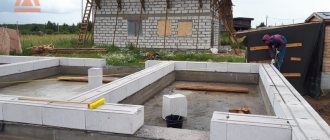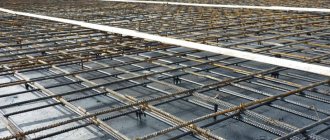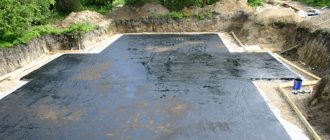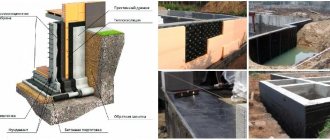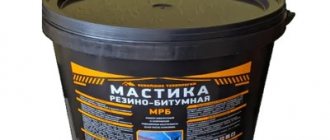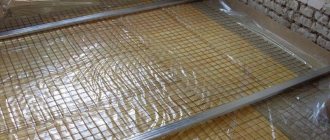The main reason for the destruction of concrete is water. A durable, reliable monolith loses its properties when exposed to moisture. The liquid, penetrating into the porous heterogeneous structure of the stone, washes out the components of the cement binder and causes corrosion of the reinforcement and mortar. Density and frost resistance decrease, destructive changes appear - cracks, chips, cavities.
Waterproofing the foundation slab Source kakpostroit.su
Types of foundation slab waterproofing
What technologies are used to waterproof a foundation slab?
- Roll materials: membranes and films. The most common type, used in 90% of cases.
- Penetrating compounds. They fill the pores of reinforced concrete and prevent capillary flow of moisture in the slab.
- Additives to concrete leading to the effect of using penetrating waterproofing (for example, Penetron Admix).
- Painting, coating and plaster waterproofing are used as additional ones: waterproofing the foundation slab from below in this way is impossible.
Roll waterproofing
Waterproofing a foundation slab with rolled materials has a number of advantages, among which it is generally accepted that it is an understandable and fairly simple application technology with high waterproofing quality. You can do this work yourself without any special professional equipment.
The result is a waterproofing layer of about 2 mm and capable of withstanding a pressure of about 0.5 MPa.
Sequence of process:
- Creation of a cushion (layer of sand, layer of crushed stone 20 cm each) and concrete preparation.
- Rolled waterproofing materials are laid on the hardened concrete preparation: in 2-3 layers using bitumen or bitumen-polymer mastic (the joints of different layers should not coincide, the material is joined with an overlap of 15-20 cm).
- The release of the waterproofing layer beyond the aisles of the future slab is done by 30-50 cm.
After this, the formwork is installed, the reinforcement frame is made and the foundation slab is poured.
After removing the formwork, the waterproofing layer is wrapped on the sides and top of the slab.
There is no need to use any other materials for waterproofing the sidewalls (coating or plaster). This may prevent the roll waterproofing from being securely attached to the foundation in these areas.
Penetrating waterproofing
After the concrete has reached 30% strength, penetrating waterproofing compounds can be applied. Concrete with 30% strength already allows movement on it, which is necessary.
Stages of applying the penetrating composition:
- Prepare the mixture. For Penetron, dilute the composition with water (0.4 liters per 1 kg of mixture) to the consistency of sour cream. It is convenient to use a mixer.
- Apply two coats to damp concrete with a brush. The previous layer must dry before applying the next one. You can use a spray bottle.
Mixture consumption is approximately 1 kg/m2.
Additives for concrete
If you mix concrete at the pouring site, you can use special additives in concrete to increase its hydrophobic properties.
Using the Penetron Admix supplement as an example, we’ll look at how to do this.
The additive is added to the water for concrete mortar (1.5 parts by weight of the additive to 1 water. The rest of the concrete mixing technology does not change.
It makes no sense to combine roll waterproofing with penetrating waterproofing. There is no pressure pressure under the base of the slab and you can get by with one of the waterproofing options.
Methods of moisture protection
Waterproofing a monolithic slab in construction is carried out in several ways:
- Coating
- it is effective, easy to use and has high durability. - Penetrating
- waterproofing the slab involves applying a special composition, which leads to the formation of special crystals. These crystals are characterized by a hydrophobic effect and do not allow moisture to penetrate into the concrete structure. - Roll
is an old and common method, which consists of hermetically wrapping a roll of waterproof material. Opinions regarding it differ radically - some experts believe that roll waterproofing of the foundation has outlived its usefulness, others believe that this is the most affordable and effective method.
It is roll materials that are most often used as waterproofing under the foundation slab from below. Due to their large area and specific location, they are more convenient than other means.
Basic principles of waterproofing
Before you begin waterproofing the foundation slab, you need to familiarize yourself with the basic requirements for this process:
The insulating layer must be as dense and airtight as possible; the formation of cracks, tears and holes must not be allowed. In places where groundwater and melt water may accumulate, additional protection must be taken. A properly made blind area is of great importance; it prevents precipitation from penetrating the foundation surfaces. After reading the current article, you can read how to waterproof a blind area. If groundwater is close, a drainage system around the building is required
This helps reduce the underground water level and prevents the destruction of the foundation. In our previous article, we talked in detail about the drainage system for a slab foundation. When choosing a waterproofing material, it is important to take into account the height of the foundation slab.
Base structure
There are two variations of slab foundations - shallow, without recess. In the first case, the plant layer of soil is removed from the base, a sand cushion and crushed stone are poured, waterproofing is laid, and formwork is installed. The next step is to knit and lay a reinforcement cage, which is gradually poured with concrete, constantly using vibration equipment for better shrinkage.
In the second case, the first three points are completely skipped; work begins by covering the soil with insulating material. The rest of the steps are the same.
This can be a poured monolith, or two or more slabs, the joints of which are filled with a cement-sand mixture.
The most preferable option is a solid fill that does not form seams, allowing you to control the density of shrinkage. Reinforcement is carried out evenly over the entire area, without displacements or differences in the width/shape of the cells.
The process of waterproofing a monolithic foundation slab
Foundation waterproofing can be done in several ways. And, of course, each option has its advantages and disadvantages. Currently the most popular are:
The operating principle of penetrating waterproofing.
- Coating. Very easy to apply, good results, long service life.
- Penetrating. Quite a new option. A distinctive feature of this composition is that after its application, crystals form in the concrete, which prevent water from penetrating into the structure.
- Waterproofing in rolls. A classic option that has been used for quite a long time. It is worth noting here that the service life of roll waterproofing is relatively short.
During the installation of a slab foundation, a problem very often arises regarding the waterproofing of the bottom slab. This is due to its fairly large area. In most cases, this problem is solved through roll or coating waterproofing.
As already noted, not so long ago roofing felt was used for waterproofing. This is a material in a roll in which bitumen is applied to a cardboard base. It is worth saying that roofing felt cannot boast of its durability, because... bitumen quickly loses its elasticity, and cardboard does not have high strength.
Composition of roll waterproofing.
At the present stage, materials are used in rolls, but already including fiberglass or fiberglass. Moreover, the bitumen contains modifying additives that make the material more elastic.
Waterproofing in a roll is quite convenient to lay under the foundation slab. It does not require a special screed. The seams that appear between the strips of material must be glued with bitumen mastic. Installation is relatively quick. For installation, you only need a burner so that you can heat the mastic.
This mastic must be applied using a roller or brush. The whole problem is that in order to waterproof the very bottom part of the foundation, you need to put a cement screed on a bed of sand and crushed stone, on which bitumen mastic is subsequently applied. After the slab has been poured, a layer of waterproofing must be applied to its sides and top.
In the same way, you can create a layer of waterproofing using penetrating compounds. The result of this application is the sealing of the concrete pores. Crystals form inside the concrete base, which prevent moisture from penetrating inside. Currently, this waterproofing option is considered optimal and modern.
Penetrating moisture protection
Penetrating waterproofing of a foundation slab involves applying a special composition, which, as a result of a chemical reaction with concrete, crystallizes and does not allow water to pass into the porous structure. The process looks like this:
- Pour a cement screed onto the sand and gravel bed.
- After drying, cover the screed with rolled waterproofing materials, laying them overlapping and gluing the joints with bitumen mastic.
- Pour the slab over this layer and wait until it dries completely.
- Apply a special penetrating compound to the side surfaces and top. It works in this way: lime, which is part of concrete, reacts with moisture in the capillaries and active substances in the waterproofing material. The result is complete sealing of the porous structure with crystalline compounds. The lifespan of these crystals is long enough to ensure the long life of the building.
There is an opinion that the penetrating method is currently more promising than others.
Why is a slab foundation waterproofed?
The monolithic mass contains small pores, which act like capillaries at high humidity.
Unprotected concrete gradually absorbs moisture, which causes negative consequences:
- the strength characteristics of the monolith decrease with constant waterlogging;
- water is concentrated in the pores, which increases in volume during crystallization;
- a damp base causes dampness in the room, which leads to the formation of mold.
In the absence of waterproofing, the foundation will gradually deteriorate. This will accordingly affect the stability of the building.
Whatever method of foundation installation you choose, it is important to remember that measures to cut off ground moisture from it are mandatory
Water protection solves a number of serious problems:
- seals concrete, maintaining its integrity. The concrete mass is weakened when moisture freezes;
- allows you to maintain a favorable indoor microclimate. Under normal humidity conditions, mold does not form;
- increases the service life of the base. The rise of moisture through the capillaries stops, which has a positive effect on durability;
- protects reinforcing bars from corrosion. Waterproofing the foundation preserves the strength properties of the reinforcement.
The impact of moisture on the foundation
Anyone who has even a superficial understanding of the properties of building materials, in particular concrete, knows the pattern - under constant exposure to moisture, it continues to gain strength over several years. This fact may cast doubt on the need for waterproofing the foundation.
However, not everything is so simple - the fact is that you need to take into account some more factors:
- The presence of metal reinforcement in the foundation structure - as is known, in addition to concrete, the foundation structure also contains a reinforcing frame made of steel rods.
Penetration of moisture into metal rods and its constant exposure leads to corrosion. Metal, turning into rust, increases in volume almost 3 times. This leads to the formation of pressure in the inner layers of concrete and gradually destroys it from the inside. Photo 1. Consequences of reinforcement corrosion in a reinforced concrete structure - Capillarity is the rise of moisture through the pores in the concrete structure, initially to the inner layers, and then upward to the wall materials.
The result is an increase in heat loss through damp walls, constant dampness inside the premises, the formation of fungi and mold, and the destruction of finishing materials. Capillary suction of moisture is effectively cut off by horizontal waterproofing of the foundation. Figure 2. Effect of capillary suction of moisture - Alternating positive and negative temperatures - when moisture freezes, it also increases in volume and over time destroys the concrete base from the inside.
Photo 3. Consequences of alternating exposure to plus and minus temperatures on concrete (an example is shown on prototypes) - Groundwater is dangerous not so much in itself, but because of the sulfates, salts and acids it contains. These chemically aggressive elements cause so-called “concrete corrosion” - over time, it begins to crumble and reinforced concrete structures lose their performance characteristics.
Cutting off moisture inside the house ↑
Waterproofing only begins with the foundation: moisture must be cut off in the structure itself. This is especially true for multi-storey panel buildings, for which floods and floods are common. There is also capillary filtration of moisture, primarily in rooms subject to constant moisture - bathrooms, toilets, kitchens.
Waterproofing of floor slabs is carried out in different ways, the main ones being roll, coating and penetrating waterproofing.
Roll materials are used mainly in kitchens and bathrooms. Before laying the decorative coating (most often it is ceramic tiles), a cement screed is applied to the laid waterproofing. It protects the material from damage and serves as the basis for high-quality tile laying. In “wet areas”, roll waterproofing is laid on the floor with an overlap of at least 20 cm on the lower part of the wall. This avoids moisture penetration in case of large leaks.
Coating waterproofing is easier to use because... applied to the prepared base using a sprayer or brush. Its advantage is a longer service life, and also that in this case there is no need for additional screed, therefore, the floor level rises slightly.
Penetrating waterproofing is the most reliable way to protect floor slabs from moisture penetration
These materials have another important advantage: manufacturers produce special joint compounds that are laid directly into the joints between the slabs. This method of waterproofing is the most reliable
Another plus is that it can be applied to mineral substrates, which include plastered surfaces, therefore, it can be used after finishing the rough finishing of walls and floors.
Waterproofing is installed at the rough finishing stage
Modern methods of protecting the base
Modern construction technologies provide three methods, including:
- penetrating: a special mixture is applied to the surface and crystallizes. A film is formed that has a hydrophobic effect, which prevents the penetration of moisture;
- roll: the method is popular in the CIS countries, whose residents use simple technology. The average service life is 2 - 3 years, no more. When using cheap material, the period is reduced to one year. It consists of covering an area with a special layer under the influence of external temperature (gas burner). Despite the short service life, this method is suitable for covering large areas;
- coating: a simple way to protect the base. Chosen due to low cost.
Principles to follow when defending:
the waterproofing layer must be intact, without damage, without defects; protection is laid at the stage of laying the foundation, or after the concrete mixture has hardened; you should not hesitate with installation, since concrete tends to accumulate moisture; where there is a high probability of groundwater, strengthen waterproofing; the formwork will take on excess moisture, thereby reducing the risk of flooding; consider installing additional drainage to drain water; When choosing a material, pay attention to the characteristics of the building material. Some liquids contain allergic agents for the human body
Those who are susceptible feel discomfort.
Rolled waterproofing under the foundation slab
Moisture-proof materials are produced on various bases:
- bitumen;
- polymer.
They are supplied in rolls and fixed in various ways:
- by fusing onto concrete using burner heating;
- by gluing using a special mastic.
The traditionally used material is roofing felt. It is a cardboard base impregnated with bitumen.
Rolled. A long-known method that is fully justified, although the durability of such waterproofing is not too great
The main advantages of the application are:
- cheap material;
- ease of fixation.
The list of disadvantages significantly exceeds the list of advantages. Weaknesses of the material:
- fragility at negative temperatures;
- insufficient strength;
- limited service life;
- tendency to cracking at bends;
- low elasticity of the hydrophobic layer.
Modern waterproofing materials are replacing outdated roofing felt:
- glass ruberoid;
- stekloizol;
- hydroisol;
- rubemast.
Installation is quite quick and simple; all you need is a burner to heat up the mastic.
Waterproofing the slab with roll waterproofing is done by laying a protective layer on a compacted gravel-sand backfill. In this case, an overlap of 15–20 cm should be ensured. Concrete can be poured onto the waterproofing material. After hardening, it is necessary to waterproof the top and end surfaces.
To do this you need:
- Clean them from dust.
- Cover with mastic.
- Cut the canvas.
- Glue the roll moisture protection.
To perform the work, you can use any type of rolled waterproofing materials.
Waterproofing a monolithic slab - methods of protecting the foundation
Builders prefer the following methods of waterproofing protection:
coating It is characterized by increased efficiency, simplicity and provides effective protection against moisture. It is carried out by applying special emulsions or mastics to the surface. According to the manufacturer's recommendations, the selected composition is applied to the surface to be treated in a heated or cold state;
It is known that water is extremely aggressive towards most building materials, and in particular to the concrete from which foundations are made
- penetrating. This is a modern and promising method of waterproofing, providing an increased depth of penetration of the protective composition deep into the concrete mass. After application, the special mixture crystallizes in concrete pores and, as a result of the hydrophobic effect, makes it difficult for external moisture to access;
- roll This is a fairly common method that involves the use of moisture-resistant materials supplied in rolls. The position of professionals regarding roll moisture protection is ambiguous. Some consider this method outdated, others focus on its effectiveness and simplicity.
The decision to use moisture protection technology is made individually, taking into account the following factors:
- location of aquifers;
- amount of precipitation;
- the presence of drainage lines;
- design features of the base;
- financial opportunities.
What is the best thing to do when building with your own hands?
At different stages of construction, waterproofing measures are taken, for which certain materials are used. Below are popular types of waterproofing, most of which can be used if you build a slab foundation with your own hands.
Roll materials
The method is suitable for protecting the base from groundwater. For this purpose, polymer films, profiled membranes and other rolled materials are used that are suitable for installation under the base of the slab.
In private housing construction they use for this purpose:
- roofing felt,
- Stekloizol,
- Uniflex,
- Linocrom,
- TechnoNIKOL and more.
Among all roll waterproofing materials, TechnoNIKOL is widely used due to its affordable cost and high performance characteristics. The canvas is laid on a flat surface with an overlap of 15 cm. They begin to roll the material from top to bottom, securing the top edge with a special strip.
Coating waterproofing agents
Coating materials include:
- special mastics based on bitumen,
- liquid rubber,
- polymer emulsion,
- various resins,
- pastes, etc.
Thanks to special additives, the mixture acquires an elastic structure, making it easy to apply by hand and retaining its strength characteristics for decades.
The entire surface of the slab foundation is covered with coating materials when the screed reaches the required strength.
Penetrating compounds
We are talking about a special impregnation that is added to the concrete solution to improve its waterproofness and frost resistance. The penetrating material can also be applied to the surface of the slab base after hardening, then the mixture is mixed with water immediately before use.
For this purpose, you can use impregnations such as:
- Penetron,
- Osmosis,
- Hydrohit et al.
After application to the surface, the substances penetrate into the concrete structure to a depth of 12–17 cm, upon contact with water they turn into crystals and clog the pores, increasing the density of the material several times.
Liquid rubber
The material is applied using spray guns to the visible surface of the slab foundation, trying to form a protective layer in the form of an even coating.
Advantages of liquid rubber:
- High water resistance.
- Elastic structure.
- Easy to apply.
- Durability of the coating.
- Good adhesion.
- Wear resistance.
Private developers may be deterred from using liquid rubber by the high price of the material, but such costs are fully offset by high-quality waterproofing of the foundation for decades.
Plastering
The material is a mineral mixture prepared using clay and cement . Such a solution hardens very quickly in air, turning into a durable protective layer that is suitable for leveling the surface of a finished slab foundation and at the same time serves as a water-repellent base.
The advantage of the technique is the low cost of preparing the clay solution.
Shielded
The method is based on the use of special mats , which create a reliable waterproofing screen on the surface of the slab foundation.
The mats are attached to mounting foam or inserted into special locks installed along the edges of the structure. It is impossible to carry out the installation on your own; licensed specialists are involved in the work.
Sprayed waterproofing materials
A high-density protective film is obtained by spraying a special material (liquid rubber, Hydroplast, Technoelast, Gidroizol, etc.) onto a concrete surface.
The water resistance of a coating with a thickness of 2–3 mm is comparable to the properties of roofing felt or other rolled material applied in several layers.
Advantages of the technique:
- high speed and ease of operation,
- no seams in the finished coating,
- elasticity,
- without toxic substances in the material, etc.
How to secure the joints of prefabricated foundation slabs: features
It should be understood that individual elements of the foundation need protection from moisture in the same way as the structure as a whole. The seams formed during installation are filled with a material such as concrete, which tends to absorb moisture to a large extent. To prevent this, it is necessary to use polyurethane cords, sealants and coating waterproofing to seal the seams.
Thus, waterproofing the foundation is a very important and mandatory process. Having penetrated the foundation, water will contribute to its further destruction. The result of what is happening will be the alteration of the foundation and major repairs. To ensure that the building is not damaged, it is necessary to think about waterproofing it at first. This process involves a lot of difficulties.
https://youtube.com/watch?v=IAur-_Ly8ic
Therefore, if you do not have certain skills in this matter, then it is best to entrust its resolution to professionals.
Why is waterproofing needed?
Concrete is a porous material, and when immersed in the ground, it begins to absorb surrounding moisture. This property leads to rapid destruction of the structure, as well as corrosion of the reinforcement, which can cause cracks in the house and moisture in the basement.
What problems does waterproofing solve:
- cuts off from groundwater, prevents flooding when the level of aquifers changes;
- prevents contact of the foundation with runoff water resulting from melting snow or heavy rainfall;
- does not allow moisture in the soil to penetrate the pores and microcracks of concrete, destroying it when temperatures change.
What will happen if there is no isolation:
- If the surrounding soil has a higher salt composition than the concrete, water, penetrating into the pores, begins to crystallize, thereby expanding the voids.
- If the surrounding soil is poor in salt content, water begins to wash them out of the base, making it very fragile due to the lack of binding components.
- When the temperature changes, movements may occur in the damp support of the house, cracks in the walls and distortions of the entire foundation may occur.
- Dampness in underground rooms, rotting of objects, and the appearance of fungal colonies on the walls, the spores of which can have a negative impact on health.
According to SP 45.13330.2012, in order to avoid destruction of the foundation from soil moisture, it is necessary to carry out insulating actions.
What is a foundation slab and moisture protection
Layout of a foundation slab with waterproofing
This type of foundation is popular among many developers, as the slab can withstand heavy loads. Such a foundation is installed at a shallow depth; it can be shallowly buried or not buried. The depth of occurrence rarely exceeds 40−50 cm, but the area of the slab foundation is quite large. A reinforced concrete slab is installed, as a rule, on a ready-made pre-made sand and gravel pad.
Depending on the permissible loads from the future building and the characteristics of the soil, slabs can be monolithic or prefabricated. Monolithic slabs are a single reinforced slab of specific dimensions and thickness; in such cases, the pit is equipped with formwork and reinforcement cage, then filled with concrete of the required grade. Prefabricated structures are reinforced concrete slabs connected into a single whole using concrete mortar, which are actively used in the construction of roads for various purposes.
Regardless of the type of base and its design, any concrete is susceptible to moisture and deteriorates over time. Therefore, waterproofing the foundation slab is done in any case and it is recommended to initially select the optimal technology.
Water is a universal solvent of mineral salts, and concrete consists of almost 100% mineral compounds. Concrete also has a porous structure due to the use of crushed stone, so water gets inside the pores and dissolves salts.
There is also the problem of damp walls. The material of the walls draws moisture from the ground, so dampness occurs inside the premises, and fungus appears, slowly destroying the structure of the house.
This is interesting: Options for waterproofing a foundation made of FBS blocks - we consider them in order
Coating protection
Coating waterproofing of a monolithic foundation slab involves applying bitumen mastic to the surface of the concrete. This creates a sealed layer that does not let moisture inside.
Coating. Quite easy to use, gives good results, durable
With this method, you should first place a thin cement screed on the sand and gravel bed and wait for it to dry. After this, the surface is thoroughly sanded and covered with bitumen mastic. To do this, you can use a roller, brush or spray.
Here it is important to ensure that the surface is completely dry at the time of applying the mastic - one drop of moisture can catastrophically break the seal.
After the mastic has dried, start pouring the monolith - when it is ready, you will need to process the side walls and the top in the same way.
Waterproofing foundation slabs
Water is an aggressive environment that negatively affects the condition of foundation slabs, which is why waterproofing measures must be carried out without fail. In this article we will look at what waterproofing a foundation slab is, how it should be done and what benefits it provides.
The article should begin with a description of the slab foundation, its structure and installation method. This type of foundation refers to non-buried or shallow-buried structures, depending on the type of soil. To lay it, you must first create a pit. The reinforced concrete slab is installed on a pre-arranged pad made of sand and crushed stone, which, in turn, was tightly compacted.
Slab foundations can be of two types: monolithic and prefabricated, each of them requires the installation of waterproofing. In the first option, the already prepared formwork is filled with ready-mixed concrete. A frame made of reinforcement is pre-installed. The second option for laying a slab foundation involves constructing a structure from pre-prepared reinforced concrete blocks, which may vary in structure.
Regardless of the type of foundation chosen, it is necessary to ensure reliable waterproofing of the slab to ensure its durability.
Water can have an extremely negative impact on the condition of many building materials, including concrete, which serves as the basis for the foundation slab. Negative consequences are associated with its porous structure, which perfectly absorbs incoming moisture.
Due to the fact that the water penetrating from the soil into the concrete contains impurities of mineral salts, the slab without proper waterproofing is destroyed. The reason for this is the processes of crystallization and increase in the volume of water, the structure is subjected to pressure from the inside, its strength decreases, which can lead to the collapse of the building.
The possible negative impact of water may also be due to the fact that when it gets into concrete, it washes out all the salts and a number of other elements from it. This leads to rapid destruction of the structure. In the absence of high-quality waterproofing of the foundation slab, the walls may begin to draw moisture from the foundation, which causes mold and dampness to appear in the house.
Foundation waterproofing can be done in several ways. Each option has certain advantages and disadvantages. At the moment, there are 3 most common methods of waterproofing a slab foundation.
• Coating insulation. A simple process of applying the material, quick and high-quality results, long service life. The material is applied manually or by machine.
• Penetrating insulation. The active chemical components of waterproofing dissolve in water and react with ionic complexes of aluminum and calcium, salts and metal oxides contained in concrete. During these reactions, more complex salts are formed that can react with water and create insoluble crystalline hydrates.
• Waterproofing in rolls. Diffuse film membranes or lining materials (roofing felt, glassine, etc.) are used, which are laid on top of a “cushion” of sand and crushed stone.
When installing a slab foundation, there may be a problem with ensuring the insulation of the bottom slab, since it has a fairly large area. The solution is to use roll or coating waterproofing of the slab.
What can the lack of waterproofing lead to?
An unprotected monolithic foundation loses its performance when exposed to moisture .
The process of destruction of concrete begins at the moment when the liquid penetrates the heterogeneous structure of concrete and begins to wash away the components of the cement binder. As a result, the density and frost resistance of concrete decreases, and cavities and cracks form in the body of the foundation.
When the liquid penetrates deep enough to reach the reinforcement frame, metal corrosion begins and the rate of destruction of the load-bearing structure increases.
Steel is very sensitive to concrete moisture . The metal, under the influence of oxygen and substances dissolved in the liquid, transforms into a state of oxides and salts. Due to potential differences, stray currents arise, leading to electrochemical corrosion, which further destroys the remains of the reinforcement frame.
The effect of liquid on the foundation is aggravated if thermal insulation was not provided during the construction process. Repeated cycles of freezing and thawing of concrete lead to the breaking of bonds in its structure.
Thus, water penetrates even deeper into the body of the foundation, turning into ice at sub-zero temperatures. The liquid, the volume of which increases in the frozen state, contributes to the further opening of existing cracks.
If the surface of the slab is not protected from moisture, then the liquid penetrates into the material of the walls , which rest on the load-bearing structure. It leads to:
- dampness in the lower rooms,
- the appearance of mold,
- fungus,
- salt stains, etc.
Cost of foundation waterproofing
Many people are familiar with the situation when a team tries to save on materials. This also applies to foundation waterproofing. As is known, the projects that are being implemented were developed by Union specialists and did not know new technologies at all. If, of course, you build a house for yourself, then most often it is done conscientiously and there is no talk of saving.
Basically, the cost of waterproofing work depends on the cost of the materials used, as well as the technology used by the specialists involved in this matter. It also depends on the surface area with which you will have to work, on the measures that will be applied. Most often, the costs are mainly spent on bitumen. And if we talk about large expenses, then these are the costs of coating materials, roll waterproofing and work on drainage arrangement on the site.
Of course, in the end, the choice to waterproof the foundation is yours. Is it worth spending money on materials and looking for an experienced team that is reliable and capable of doing everything properly? But remember, it may be better to incur the costs of all this now than when the time comes to save your home and carry out waterproofing in such a short time, it can cost you much more. And as mentioned above, it is necessary to take the specialists who will carry out this work more seriously. Once you make a mistake, you will have to do everything all over again, starting with finding competent people who know how to work in this area.
Solid floating foundation
It happens that the owners do not need a basement, then digging a pit is not done, and the monolithic foundation is made directly on the crushed stone cushion. Such a slab will serve as the floor for the first floor and at the same time as the foundation. Therefore, insulation work to protect the foundation is also sexual treatment.
This type of foundation for a house is called a floating foundation. Because they are cast above the freezing zone of the soil, actually on the surface. Therefore, they experience all the vibrations of the underlying ground that occur during freezing in winter and thawing in spring. All loads occurring in the soil are transferred to the foundation, and the house, together with the foundation, either rises or settles.
Until recently, such options were used in the construction of shops and pavilions, but now this foundation option is often used when building a country house, especially where the soil is heaving.
